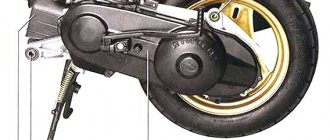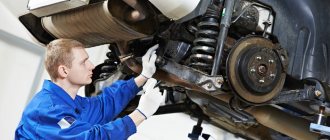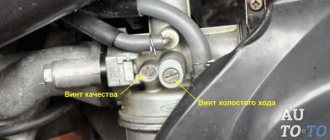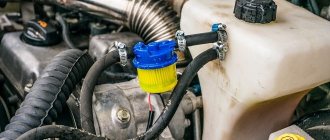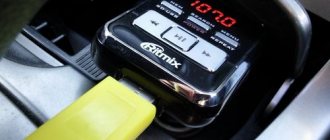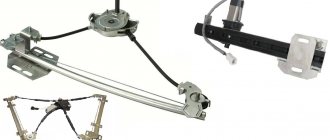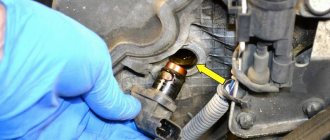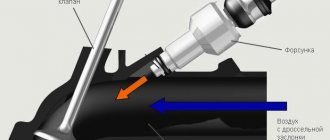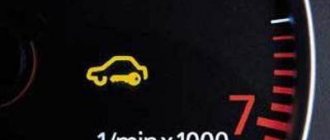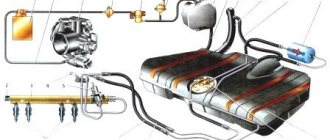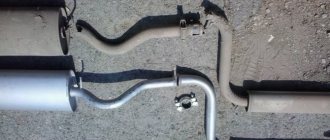Currently, all trim levels of Lada Vesta and XRAY cars, as well as “Lux” versions of Lada Granta and Kalina with AMT (robot), are equipped with a hill start assist system (HSA or HHC). It makes starting on slopes easier by holding the vehicle in place and preventing it from rolling down the slope. Let's figure out how it works and what reviews the owners of these cars leave about it.
Security program features
Electronic vehicle control simplifies control in difficult and extreme situations, reducing the risk of skidding. Electronic Stability detects the vehicle's direction of travel and then applies brakes on individual wheels to keep the vehicle moving in the desired direction.
The program uses:
- anti-lock braking system (ABS);
- electronic brake force distribution (EBD);
- electronic differential lock (EDL) systems;
- traction control systems (ASR).
Newer versions also feature a dry brake feature, which means the system wipes water off the brake discs at certain regular intervals, applying the brake pads to provide greater stability and shorter stopping distances, even in the rain.
The developer of the system was Toyota Corporation. This manufacturer takes driving safety seriously and therefore introduces Toyota's famous Star Safety System offered on every one of its vehicles.
Description of the operating algorithm
Hill start assist is available in some cars and is considered an optional extra for premium cars and SUVs.
SPP allows you to avoid a situation where the car rolls down when climbing a mountain. Or when the car starts downhill at an angle of 5 degrees. The system is activated both when the car is moving forward and in reverse.
Thanks to the presence of a hill start assist system, the risk of an emergency on a road that is located on a slope is minimized. If you activate the SPP, you do not have to apply the brake.
Design and principle of operation using the example of Lada Vesta
The principle of operation of Hill Start Assist on a Lada Vesta car is not very different from the general approach used on other cars.
The device works on the principle of reducing pressure in the brake system after releasing the gas pedal.
There are three components required to activate an HSA:
- The car is started;
- The brake pedal is depressed;
- The tilt angle exceeds 5% (unless another parameter has been previously set).
The device itself operates on the basis of four cycles (phases), each of which performs a specific task:
- Sufficient brake pressure is created for operation;
- Ensures that the brake pressure is maintained;
- The pressure in the brake system decreases;
- Pressure is released.
At the moment the brake is pressed (at the time of ascent), the brake system performs its functions provided that the valves (switching and inlet) are open. As a result, Hill Start Assist provides braking pressure to keep the car in one place.
After the brake is released, the switching valves close, and the required pressure is maintained in the brake circuits, which prevents the car from rolling away when the foot is moved from pedal to pedal.
As soon as the throttle valve opens (the gas pedal is depressed), the bypass valves open. This factor helps reduce brake pressure.
After the motor rotation torque reaches the required frequency, the switching valves open 100%, which guarantees pressure relief.
It is worth noting that Hill Start Assist only works on ascents. An interesting fact is that the direction of movement does not matter. So, the device will work even when driving uphill in reverse.
Hill Start Assist has become a salvation for beginners who have to drive on city streets from the first days of driving. As for experienced drivers, the presence of such a system is not necessary for them. In addition, when buying a car with a manual transmission, HAS brings more headaches than real benefits.
So you should think about whether it’s worth paying extra for such an option or not.
System operating modes
When the hill start assist system starts, the following modes are activated:
- the braking force of the system increases;
- Brake pressure is maintained until the car starts moving;
- the braking force gradually decreases;
- The brake pressure is completely relieved.
This is exactly how an experienced driver acts if the need arises to climb a slope. But even the best specialist will not be able to simultaneously adjust the braking force of each wheel separately.
This leads to the fact that even experienced car enthusiasts experience skidding situations or the car slides down if the opposite drive wheels have different levels of grip on the road surface.
What kind of system is this?
The name speaks for itself; the system is designed to help the driver start on an incline. We were all once beginners and each of us had problems with starting off when the car is tilted and tries to roll back. This phenomenon, if there is no obstacle or car behind, is, in principle, not scary. However, on a busy road, rolling backwards is quite dangerous; no, a major accident will most likely not happen, but your own, as well as other people’s, property will be damaged.
The name of this system, as a rule, is indicated by, yes, you guessed it, another abbreviation. Depending on the manufacturing company, it may be called differently: HAC, HSA, HG, HHC, USS. Each manufacturer has its own developments, however, the systems are not fundamentally different and work on the same principle. On premium class cars, in principle, they never write about the presence of this system, since it is installed by default, that is, it is commonplace.
N.S.A.
The HSA hill start assist system protects the car from the following negative aspects that are dangerous for the car and its passengers:
- the engine stopped because the driver did not press the accelerator pedal enough or the load level simply increased;
- the wheels were slipping because the wheels had insufficient adhesion to the road surface;
- the car rolled away;
- The vehicle was not moving properly because the road surface was too slippery and the drive wheels had different traction conditions.
On what vehicles can the system be used?
As you know, the system itself is designed to protect cars from rolling when starting to move on an incline whose slope exceeds 5 degrees. Initially, the developers planned to use it only on models equipped with an automatic transmission. However, after the excellent results demonstrated by the service when working in tandem with an automatic transmission, manufacturers decided to try to use a similar system on vehicles equipped with a manual transmission. Despite the fact that the developers revised the principle of operation of the assistant and tried to adapt it to “mechanics”, reviews of its work in this case are not as good as for cars with automatic transmission. The main problem is that the service does not understand when the driver starts moving and when he performs a normal change of gas. As a result, instead of help, the car owner may end up with additional problematic situations. Therefore, if a car equipped with a manual transmission is equipped with such a service, the driver will need to undergo a series of training to adapt to its operation.
Operating principle
How does Hill Start Assist work? It will be successfully activated if the following conditions are met and you know how to properly use the provided capabilities:
- engine performance;
- pressing the brake pedal;
- when the angle of inclination of the road surface exceeds five degrees.
The hill start assist system HAC will be deactivated if the incline angle is less than the specified one. The driver must then rely on mechanical means of driving control.
Advice for novice car enthusiasts
We can offer several general recommendations that apply to beginners in driving:
- For movement over rough terrain and off-road, the installation of a control system is required;
- in the event of a malfunction of the ESP system, the checkbox will also not function, since the latter is a built-in algorithm of the first system;
- It is imperative to turn on the SPS if the upward climb is on a bad road.
Disassembling pantographs
Description of a road sign that removes all restrictions
When disassembling, loosen the springs to prevent shock during spontaneous lifting. Then the flexible shunts are disconnected, the rollers are removed and the skids are removed. The upper components of the current collector are sequentially dismantled and the carriages are removed. If the parts are in good condition, the upper part is not disassembled, springs, holders and shunts are not removed, but be sure to inspect all hinge units. By further weakening the pressure of the lifting springs, the earring rollers are knocked out. Then the springs are removed and the earrings and cores are turned onto them. Disassemble the hinges and remove the upper movable frames. The lower frames and base cannot be disassembled.
HSA (Hill Start Assist) for the Duster car
The described SPP is intended for use in Sandero, Logan and Duster cars. The hill start assist system has its own application features. It is important to remember that if the vehicle is stopped on an incline, the driver will not need to exert any extra effort. Its actions are reduced to fully squeezing the brake pedal. When the driver releases the pedal, the car will stop for a second. During this time, the driver will have time to move his foot on the gas pedal and begin to control his vehicle.
What cars is it installed on?
There is some debate among car enthusiasts about which vehicles HSA is intended for. Initially it was planned for cars with an automatic transmission.
Over time, the system was improved, and it was used on different types of gearboxes (including manual ones).
The worst performing combination was the manual transmission and HSA. The reason lies in the principles of the system.
The Hill Start Assist device responds to three components - pressing the brake pedal, releasing and opening the throttle valve (pressing the accelerator pedal). The pads stop working after turning on the transmission and increasing the speed.
In the case of manual transmissions, a decrease in pressure is possible in case of over-throttle at neutral speed. As a result, the car rolls back. The driver does not expect such a trick from the device and ends up in an accident.
POPULAR WITH READERS: What is an idle air solenoid valve
The reason is that Hill Start Assist is not able to clearly recognize the throttle change and the start of movement on a manual transmission.
This is why HSA in combination with “mechanics” is practically not in demand
If such a system is installed on your manual car, then you should be careful on descents, because the unit fails at an unpredictable moment
Let's sum it up
NAS is a control system that helps the vehicle cope with steep road inclines when the incline angle exceeds five degrees. With lower values, the SPP simply will not be able to activate. NAS provides protection against wheel slip when the machine is just starting to climb and may slide down a slippery slope. After all, sometimes the heavy body of a vehicle pulls it back if the speed is low.
The benefit of using Hill Assist is that you can move uphill without the risk of being in danger of losing control. If the car goes up a steep slope and there is a danger of it rolling, NAS will prevent the danger and report the problem to the car owner. The system recognizes a situation when one of the wheels begins to slip. Then she will have to automatically distribute the torque to restore the traction of the tires and the road surface.
NAS controls the wheels and makes them brake from time to time. This is necessary to restore contact with the road with tires that are slipping. Thus, the use of Hill Start Assist provides the driver with the benefits of vehicle control.
Hill Assist System
Every motorist sooner or later encounters difficulties when starting, and therefore the world's leading automobile brands have developed a special system of assistance when climbing uphill - Hill Start Assist (HSA).
Particularly difficult are felt in urban environments with heavy traffic. The HSA system is the best option for inexperienced drivers when starting uphill, as it controls and blocks the car when rolling down a slope in the first seconds before starting to move.
The HSA system is installed on cars from all leading car manufacturers and on almost all heavy SUVs.
How does the hill climbing assistance system work?
When the vehicle stops on a slope whose inclination angle exceeds 5 degrees. The driver can only hold the vehicle with the brake pedal, since in the first seconds before the vehicle begins to move, the car may begin to roll back. Whereas the HSA system is able to prevent the slightest movement of the car backwards and hold it for about 2-3 seconds until upward movement begins.
Important: the system is activated only when the brake pedal is pressed hard, while lightly touching the brake pedal does not activate the anti-recoil system. How it works and the main advantages of HSA
How it works and the main advantages of HSA
The undoubted advantages of the lifting assistance system are: That she herself can recognize slope angles starting from 5 degrees. Thus, on a flat road this function does not work.
Another plus is the automatic activation of the system, which eliminates the use of the handbrake.
An equally important aspect can be considered the activation of the HSA system both when moving forward and when the car rolls back.
The HSA function can prevent the car from slipping on a slippery road and can inform the driver about rolling back.
When the car begins to slip, the system redistributes the intensity of the torque, and the wheels that have close contact with the surface begin to brake, which creates optimal conditions for contact with the road for the slipping wheels.
How Hill Assist works: The driver presses the brake pedal, which opens the intake valves and simultaneously closes the exhaust valves. High pressure is created in the brake system, which provides braking. When the driver releases the brake pedal on a slope, the intake valves close while the exhaust valves are already closed. At the same time, pressure is maintained in the brake system until the car starts moving.
Names and designations of the lifting assistance system from manufacturers
HHC (Hill Hold Control) - used in their cars by automakers BMW and Volkswagen
HH (Hill Holder) - can be found in models from Fiat, Subaru
HAC (Hill-Start Assist Control) - Toyota Corporation produces and equips its cars
DBS is what Hyundai labels its hill assist system.
USS (Uphil Start Support) - developed by Nissan
The main positive aspect of the hill climb assistance system is to prevent the car from rolling back, especially on extreme sections of the route, which in turn helps to avoid road accidents.
The American Dream remains a reality. Cadillac introduced new crossovers
See all photo news >>
